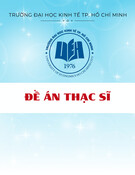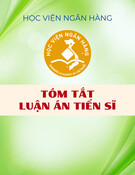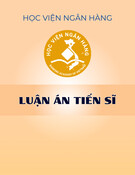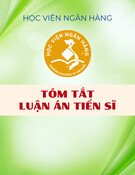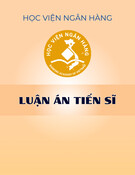2
1
INTRODUCTION
2. Research purposes This study generally focuses on analyzing the impact of credit risk
1. The necessary of the study Credit risk affects the bank’s prosperity and sustainability by
on profitability at Vietnam joint stock commercial banks. Specifically:
influencing its profitability. There are many studies looking at the
(i) considering the impact of credit risk arising from on-balance-sheet
effect of credit risk on bank profitability, however, these studies only
and off-balance sheet activities at Vietnam joint stock commercial
employed on-balance sheet credit risk measures (arising from loans)
banks; (ii) considering the impact of credit risk on ROA, ROE in
without paying much attention to the credit risk of off-balance sheet
Vietnam joint stock commercial banks in the period 2009-2018 as a
items. The conclusions from these studies are still inconsistent, that
linear or non-linear relationship; (iii) considering the impact of credit
credit risk may have positive or negative effects on ROA, ROE, and
risk on profitability in Vietnam joint stock commercial banks with
positive effects on NIM. Meanwhile, the theoretical basis and current
differences in the size of total assets; (iv) proposing recommendations
situations in Vietnam show that the impact of the credit risk on bank
derived from research results to limit credit risks and promote
profitability may be a non-linear relationship.
profitability at Vietnamese joint stock commercial banks.
In recent years, the bad debt ratio in Vietnam commercial banks
The author has proposed the following research questions:
has increased sharply, eroding their profit before tax due to the
i) How does credit risk arising from on- and off-balance sheet
provision of credit risk reserve. Besides, the proportion of off-balance
activities affect the bank profitability at Vietnam joint stock
sheet items to total on-balance-sheet assets has tended to increase in
commercial banks?
recent years. Changing the credit risk provisioning for off-balance
ii) Is the impact of credit risk on profitability ratios (ROA, ROE)
sheet items since 2014 can also have negative long-term effects,
at Vietnam joint stock commercial banks in the period 2009-2018 is a
especially in a developing economy like Vietnam. With the
non-linear relationship?
restructuring roadmap, in the coming time, Vietnamese commercial
iii) Is the impact of credit risk on profitability ratios at Vietnam
banks must increase their capital to meet capital safety conditions.
joint stock commercial banks different by asset size?
Therefore, the effect of total assets size on the impact of credit risk on
3. Subjects and scope of research Research subjects: The impact of credit risk on profitability in
bank profitability should also be considered.
Vietnam joint stock commercial banks.
Thus, it can be seen that the research on the impact of credit risk
on bank profitability is an objective requirement from practice in
Research scope: + Space: 31 Vietnam joint stock commercial banks.
Vietnam. Therefore, the topic “The impact of credit risks on the
profitability at Vietnam joint stock commercial banks” is selected for
+ Time: from 2009 to 2018. 4. Methodology
this desertation.
4
3
Aprroach:
sheet activities has a negative impact on ROA and ROE, so the risks
+ The thesis uses a combination of traditional profitability ratios in the
from these activities need more attention in the long term, especially
banking sector (ROA, ROE, NIM), and at the same time uses the
in the context of off-balance sheet activities and the derivative stock
measure of credit risk arising from both on- and off-balance sheet
market in Vietnam is developing day by day.
activities which hoping to bring about the most consistent estimation.
Secondly, the thesis provides for the first time empirical evidence
+ Research data is presented as unbalanced table data for the period
of the non-linear impact of credit risk on ROA and ROE at Vietnam
from 2009 to 2018. Data on bank characteristics and microeconomics
joint stock commercial banks. This result shows that low/moderate
are collected and calculated from database of Vietstock, World Bank
credit risk will boost commercial banks’ profitability, but if credit risk
and the State Bank of Vietnam.
rises above the optimal threshold, its increase will decline profitability
+ The thesis builds a research model on the impact of credit
due to the erosion of the risk provision for operating profits as well as
rireprodbank profitability as well as the factors that influence this
financial losses when the customer violates the obligation to repay.
relationship such as the ratio of loan to total assets, capital structure,
Thirdly, the thesis examines the effect of the total assets on the
income diversification, cost effectiveness, total assets, market
impact of credit risk on bank profitability,
thereby giving
concentration, economic growth and inflation. Besides, the thesis uses
recommendations and policy implications close to reality.
6. Desertation structure
dummy variables and interactive variables related to the total assets to
clarify research objectives.
The thesis is presented in five chapters:
Chapter 1. Literature review.
Methodology The thesis employs the two-step system GMM estimation method
Chapter 2. Theoretical framework.
to examine the impact of credit risk on bank profitability in order to
Chapter 3. Methodology.
handle endogenous problems and potential defects, allowing to
Chapter 4. Research results.
Chapter 5. Conclusions and recommendations.
generate exactly estimated results.
5. New contributions of the research Although the impact of credit risk on bank profitability is a
traditional topic and has been concerned by many researchers, this
thesis still has some new contributions as follows:
First, this can be seen as a pioneering study in the use of credit risk
provision to measure credit risk arising from off-balance sheet
activities at Vietnam commercial banks. Credit risk from off-balance
6
5
1.1.4. The non-linear impact of credit risk on ROA, ROE
CHAPTER 1: LITERATURE REVIEW
Previous studies show that the effect of risk on returns can be non-
linear, specifically: during periods of low or medium volatility, the
1.1. Overview of research works related to the topic 1.1.1. The impact of on-balance sheet credit risk on ROA, ROE
trade-off relationship between risk (due to volatility market) and the
With the bank profitability measured by ROA, ROE and on-
expected return is positive; on the contrary, during periods of strong
balance sheet credit risk measured by non-performing loans ratio or
market volatility, this relationship is inverse. However, to the extent
loan loss provisions ratio, most previous studies have shown a
of the author’s understanding, the empirical evidence on the non-linear
negative impact of credit risk on ROA, ROE. However, with the same
impact of credit risk on banks’ profit has not yet been studied,
measures as above, others show that the impact between these two
especially at Vietnamese commercial banks.
variables is in a positive direction, especially research in developing
1.1.5. Estimation methods
countries such as Ghana, Tunisia, Bangladesh, MENA, China.
Perivious studies have used different estimation methods such as:
1.1.2. The impact of on-balance sheet credit risk on NIM
Ordinary Least Squares (OLS), Fixed Effects Model (FEM), Random
With the bank profitability measured by NIM, most studies have
Effects Model (REM), General Method of Moments (GMM). In
shown the positive effect of credit risk (measured by non-performing
particular, GMM is still considered as the optimal method to deal with
loans ratio and loan loss provisions ratio) on the dependent variable.
the potential defects of the research model, providing more efficient
1.1.3. The impact of off-balance sheet credit risk on bank
and accurate estimation results.
profitability
1.2. Research gaps
Previous studies show that off-balance sheet transactions are
First, credit risk measurements are commonly used in previous
associated with bank risks and negatively impact on bank profitability.
studies including the non-performing loans ratio and loan loss
When these transactions increase, risks will arise due to the moral
provisions ratio. However, credit risk arising from off-balance sheet
hazard effect and the negative long-term impact of off-balance sheet
items has not been considered and interested, especially studies in
activities on bank profitability should be paid more attention. Research
Vietnam. Therefore, the author proposes to make provision for credit
overview in Vietnam shows that studies on off-balance sheet activities
risk arising from off-balance sheet items even when there are no
are still very limited. To the author’s best of knowledge, up to now,
obligations to fulfill banks’ commitments. With the expectation that
there have been no studies in Vietnam that have proposed a specific
credit risk will be considered more comprehensively, this thesis will
measurement to measure credit risk arising from off-balance sheet
include both on- and off-balance sheet credit risk. Up to now, in
activities.
Vietnam, there is no research to mention the provision for credit risk
arising from off-balance sheet items.
8
7
Second, some studies have shown the relationship between risk and
income against revenue, operating costs, assets and shareholder equity
return is a non-linear relationship in an inverted U-shape. On the other
at a specifically time.
hand, through an overview of the theoretical basis and the situation of
2.1.2. The indicators reflect the bank profitability Returns on Average Total Assets (ROA)
bad debt and bank profitability in Vietnamese, the author suspects that
The rate of return on average total assets is an indicator reflecting the
there may exist a nonlinear U-shaped relationship between the credit
level of profit that a bank can receive over its assets, a measurement
risk and ROA, ROE at Vietnamese commercial banks in the research
of the managing efficiency and using assets to generate income.
period. Therefore, this study can be considered as a pioneer in
Profit after tax
providing empirical evidence of the non-linear effect between credit
ROA =
risk and bank profitability (ROA, ROE) in Vietnam.
Average Total Assets
Third, the Vietnamese banking sector is undergoing restructuring
Returns on Average Equity (ROE)
with a series of mergers between banks, leading to the formation of
Return on average equity reflects the income that shareholders or
larger banks. Increasing the total assets can have a positive impact on
investors can get on the money they have spent.
a bank’s profitability, but also may reduce the bank’s performance due
Profit after tax
ROE =
to management reasons, office costs. However, up to now, there has
Average Equity
been no study comparing the impact of credit risk on bank profitability
Net Interest Margin (NIM)
by groups of banks with differences in total assets size. Therefore, this
The net interest margin is the difference between the bank’s interest
study will contribute to clarifying the impact of the total assets on the
income and its cost of interest payments over its average interest
impact of credit risk on profitability at Vietnam joint stock commercial
earning assets, representing the actual income the bank receives from
banks in order to make policy implications consistent with reality.
the difference between loans and capital mobilization interest rates.
Net interest income
NIM =
CHAPTER 2: THEORETICAL FRAMEWORK
Average Total interest assets
2.1. The bank profitability
Risk-adjusted rates of return
2.1.1. The concept of profitability
Risk-adjusted return on capitals (RAROC), risk-adjusted return on
According to Rose (1999), the profitability is the ratio of net
total assets (RAROA) and risk-adjusted return on equity (RAROE).
income after tax to total assets or equity. Profitability ratio is a group
2.2. Credit risk of commercial banks
of financial indicators used to evaluate a bank’s ability to generate
10
9
2.2.1. Credit risk concept
In principle, the purpose of loan loss provisions is to adjust the provision
The Basel Committee on Banking Supervision (Basel, 2000)
for losses to reflect expected future losses in the bank’s loan portfolio.
Loan loss provisions
defined “credit risk is the ability to lose part or all of the value of a
LLP =
loan due to credit problems such as the borrower violation of debt
Total loans
repayment obligations, divestment or delay in repayment, or change
Off-balance sheet credit risk
in loan interest rate”.
There are many studies on the risks of off-balance sheet activities, but
Commercial banks increasingly face credit risk not only in lending
these studies do not separate credit risk and consider the overall risks
activities but also in many other activities. Although there is no
brought about by these activities. Therefore, the author will propose
specific concept of the credit risk of off-balance sheet activities, the
off-balance sheet credit risk measurement in the next chapter.
Bank for International Settlements (BIS) has emphasized that the risks
Others
of off-balance sheet transactions, especially credit risks, there is no
Net Charge-Offs (NCO), Standard deviation of Net Interest Margin.
difference from on-balance sheet activities and should be analyzed in
2.3. Other determinants of the bank profitability
the same way as credit risk of on-balance sheet activities (BIS, 1986).
2.3.1. The bank characteristics
Credit risk arising from off-balance sheet activities can be
understood as unexpected losses that banks can suffer when
partners/customers default or breach committed obligations due to
changes in financial capacity in the process of engaging in off-balance
sheet transactions. When customers default, the bank must fulfill its
The loans to total assets ratio Capitalization Cost efficiency Income diversification Total assets
commitments, that is, convert these off-balance sheet activities into
on-balance-sheet loans.
2.2.2. Credit risk measurement indicators Non-performing loans ratio (NPL)
This indicator directly reflects the credit risk situation of the bank, and
2.3.2. Macroeconomics factors Industry concentration Inflation Economic growth 2.4. Foundational theories
at the same time shows the size and the rate of difficult-to-recover
2.4.1. Risk-Return Trade-off Theory
capital in the bank’s loan portfolio.
First mentioned by Markowitz (1952) and further confirmed by
Non-performing loans
Sharpe (1964), Lintner (1965) and Merton (1973). Accordingly, the
NPL =
Total Loans
higher the risk of an asset/investment portfolio, the greater the return that
Loan loss provisions ratio (LLP)
investors expect to achieve. However, Whitelaw (2000), Rossi &
12
11
Timmermann (2010), Ghysels et al. (2013), Aragó & Salvador (2013)
agree with the view of the non-linear impact of risk on return: in the period
of low or medium volatility in the market, the relationship between
market volatility risk and expected return is positive; by contrast, during
periods of strong market volatility, this relationship is inverse.
2.4.2. Information Asymmetry Theory
First mentioned by the “lemons” hypothesis of Akerlof (1970),
Stiglitz & Weiss (1981) developed this theory through two effects,
adverse selection and moral hazard. According to both effects
mentioned above, lending interest rates affect credit risk and
profitability of banks: increasing lending interest rate means that credit
Figure 2.1. Research model framework
risk of the loan portfolio also increases, leading to reducing
Source: Author
profitability of the bank. Stiglitz & Weiss (1981) also shows that when
the lending interest rate reaches a certain level of r*, the bank’s profit
CHAPTER 3: METHODOLOGY
is maximum. On the other hand, if the bank increases the interest rate
3.1. Research model
beyond a certain r*, it increases the risk of the loan and therefore
3.1.1. Choice of dependent variables
reduces the bank’s profit.
The thesis employs three measurements of bank profitability,
2.4.3. Other hypothesis
namely ROA, ROE, NIM.
Berger & DeYoung (1997) developed hypotheses such as: Bad
3.1.2. Choice of independent variables
luck hypothesis, Bad management hypothesis, Skimping hypothesis,
The thesis uses two measurements, namely On-balance-sheet
Moral Hazard hypothesis.
credit risk provision and Off-balance sheet credit risk provision ratio.
2.5. Research theoretical framework
3.1.3. Choice of control variables
On the basis of research overview and theoretical basis, the author
Including bank-specific variables and macroeconomic variables.
constructs the research theoretical framework presented in Figure 2.1.
The variables used are summarized in the table below:
14
13
Table 3.1. Explain the variables in the research model
Where:
Variables Measurement
+ Y are the dependent variables measuring bank profitability,
Expected sign
including ROA, ROE, NIM
+ X are independent variables measuring credit risk, including LLP
and OBS
Bank profitability ROA ROE NIM
+ Ctr are control variables, including variables belonging to the bank
Profit after tax/Average Total Assets Profit after tax/Average Equity Net interest income/Average Total interest assets
characteristics and the macro environment.
Credit risk LLP +/–
+ The parameter p is the ordinal number of the credit risk and control
variables (p є [1,k]), i represents the i bank and t represents the year t.
OBS +/– Provision for on-balance sheet credit risk /Total loans Provision for off-balance sheet credit risk /Total off-balance sheet items
3.2. Research data
3.2.1. Source of data
Total loans/Total Assets +
Data on bank characteristics are collected and calculated from
annual reports and audited financial statements of 31 joint stock
+/– –
commercial banks in Vietnam. Macro-environment data is collected
from the World Bank database.
3.2.2. Description of research data
+/- +/– +/– Bank characteristics LA (Loans to Assets ratio) ETA (Capital Structure) HHI (Income Diversification) COST (Cost Efficiency) LNTA (Bank size) SIZEdum (Dummy variable on the size of total assets)
3.2.2.1. Descriptive statistics of the study sample
Equity/ Total Assets (Interest income/Total income)2 + (Non-interest income/Total income)2 Operating expenses/Total Assets Natural logarithm of total assets Equal to 1 if total assets are more than VND 100,000 billion; equal to 0 for the remaining cases
Table 3.2. Descriptive statistics of variables
Variable Number of Mean Median Standard Min Max + observations deviation Macroeconomic CR3 (Industry concentration) INF (Inflation) +/– ROA 298 0,8359 0,7148 0,6053 0,053 2,4476 ROE 298 9,1525 8,03 6,8802 0,2019 27,493 GDP (Economic growth) rate of gross domestic + The assets proportion of three largest commercial banks Growth rate of consumer price index (CPI) Growth product NIM 298 2,7598 2,7174 1,0530 0,5466 5,255
Source: Author
LLP 298 1,2641 1,152 0,4568 0,2402 2,3166
3.1.4. Research models
OBS 298 0,7288 0,75 0,2534 0,1015 1,1857
Based on research overview of domestic and foreign authors, the
LA 298 0,5412 0,5546 0,1232 0,3134 0,8163
research model of the desertation has the following form:
ETA 298 9,6218 8,71 3,8090 3,2572 17,915
Yi,t = α + Σβp (Xit + Ctrit) + εit
HHI 297 0,7207 0,7101 0,1365 0,5001 0,9596
16
15
COST 297 1,5750 1,554 0,4693 0,369 2,689
CHAPTER 4: RESEARCH RESULTS
LNTA 298 18,189 18,202 1,1570 15,018 20,995
4.1. Situation of Vietnam’s commercial banking system
CR3 310 40,845 40,472 4,9183 31,663 50,498
The thesis has presented an overview of the size and number of
INF 310 6,138 5,651 3,5960 0,879 13,885
banks, income structure, off-balance sheet activities as well as the
GDP 310 6,1492 6,2255 0,6010 5,247 7,076
reality of credit risks and profitability rates in the period 2009-2018.
4.2. Research results
Source: Stata
4.1.1. Linear impact of credit risk on profitability
3.2.2.2. Correlation coefficient matrix
Table 4.3. Estimation results of the model of linear impact of
The correlation coefficient matrix between the explanatory
credit risk on profitability
variables shows that most of the correlation coefficients are below 0,5,
Dependent
showing that there is no close correlation between the pairs of
ROA ROE NIM variables
explanatory variables. Multicollinearity may occur between LNTA
and ETA variables (73.2%).
Models (1) (2) (3) (4) (5) (6)
3.2.3. Check the robustness of research data
ROAt-1 0,5710*** 0,6096***
The tests show that the models have a suitable format. However, the
ROEt-1 0,7272*** 0,5571***
models may experience multicollinearity (mean value of VIF is
NIMt-1 0,2197*** 0,2564***
greater than 2.5), heteroscedasticity (occurs in all models) and series
LLP -0,1588*** -2,0919*** 0,2827**
autocorrelation (occurs in all models).
OBS -1,0218*** -19,702*** -0,1681
3.3. Estimation method
LA 0,5407* 0,5653*** 0,7642 9,9667*** 3,1069*** 1,4375***
For reliable research results, the author will use two-step system
ETA 0,0186** 0,0158* 0,1558** -0,1098 -0,0461* -0,0550***
generalized moment estimation method (2-step System Generalized
HHI -2,3520*** -1,8135*** -23,143*** -15,897*** 1,9147*** 0,7164**
Method of Moments - 2-step SGMM). Besides, the thesis uses tests
COST 0,0979* 0,0874* 0,9176* 1,6723** 0,9458*** 1,1969***
such as Sargan, Hansen, Arellano–Bond to check the appropriateness
LNTA 0,0082 0,0100 0,3256 0,3834 -0,2035*** -0,1284***
of the estimation method.
CR3 -0,0041** -0,0041* -0,0805*** -0,0561*** 0,0105*** 0,0135***
Since the estimation method is GMM, the research model will be
INF 0,0489*** 0,0396*** 0,2554*** 0,3475*** 0,0760*** 0,0977***
adjusted as follows:
GDP 0,2171*** 0,2446*** 2,3265*** 2,6061*** 0,0763 0,1133***
Yi,t = α + δYi,t-1 + Σβp (Xit + Ctrit) + εit
No. groups 31 31 31 31 31 31
Where Yi,t-1 is the 1-period lag variable of the dependent variables.
No. Instr. 29 29 30 28 30 30
18
17
F-test No. groups 0,000 0,000 0,000 0,000 0,000 0,000 31 31 31 31 Sargan test No. Instruments 0,103 0,260 0,985 0,779 0,090 0,836 30 29 31 31 Hansen test F-test 0,491 0,409 0,702 0,588 0,285 0,196 0,000 0,000 0,000 0,000 AR(1) Sargan test 0,000 0,001 0,004 0,001 0,042 0,006 0,980 0,272 0,886 0,985 AR(2) Hansen test 0,608 0,883 0,207 0,624 0,987 0,577 0,695 0,489 0,887 0,740 AR(1) Note: (*), (**), (***) are at 10%, 5% and 1% significance level respectively. 0,016 0,005 0,007 0,004
Source: STATA
AR(2) 0,611 0,452 0,152 0,299
4.1.2. Non-linear impact of credit risk on profitability
Note: (*), (**), (***) are at 10%, 5% and 1% significance level respectively.
Table 4.4. Model estimation results of non-linear impact of credit
Source: STATA
risk on ROA, ROE
4.1.3. The impact of credit risk on the profitability ratio of the bank’s
Dependent variables ROA ROE
total assets
(7) (8) (9) (10) Models
Table 4.5. Estimation results of the model of the effect of total asset
size on the impact of credit risk on profitability
ROAt-1 0,5326*** 0,5423***
Dependent variables
ROA ROE NIM ROEt-1 0,7759*** 1,0391*** Models (11) (12) (13) (14) (15) (16) NIMt-1 ROAt-1 0,4879*** 0,5144*** LLP 1,0837*** 10,824*** ROEt-1 0,6025*** 0,6119*** LLP2 -0,3780*** -3,6386*** NIMt-1 0,1982*** 0,1734*** OBS 0,9055* 19,218** LLP -0,5093*** -2,6987*** -0,0836 OBS2 -0,7425** -14,895** OBS -1,8849*** -16,129*** -0,7464 LA -0,6241 0,6587*** 0,5355 5,5390** LA 0,0483 0,3749* 5,9682** 7,8637** -0,1051 0,9043 ETA -0,0480*** -0,0229*** -0,2343*** -0,3381*** ETA 0,0666*** 0,0656*** -0,2014 0,4754** 0,0159 0,0166 HHI -0,8662** -1,2275*** -9,2917*** -9,9908*** HHI -1,9174*** -1,5862*** -14,943*** -18,388*** 0,9623*** 1,4526*** COST 0,3070*** 0,1385* 1,0645* 1,4523** COST 0,0940* 0,0402 1,9661** -0,3255 0,8584*** 0,5313*** LNTA -0,0151 -0,0325** -0,6034*** -0,7220*** CR3 -0,0070*** -0,0039* -0,0486** -0,0526** 0,0057** 0,0080** CR3 -0,0001 -0,0009 -0,0958*** -0,0700*** INF 0,0472*** 0,0438*** 0,3653*** 0,3155** 0,0589*** 0,0806*** INF 0,0310** 0,0531*** 0,0732 0,2095** GDP 0,2380*** 0,2876*** 2,0219*** 3,1492*** -0,0732 -0,1195 GDP 0,0977** 0,1541*** 2,5507*** 2,3160***
20
19
SIZEdum
Fifth, the estimated results show a positive correlation between cost
-0,2870* -0,8697*** -3,3582*** -5,3465** 0,3923 1,4842
effectiveness and dependent variables.
SIZEdum*LLP 0,4608*** 2,9785*** -0,1845
Sixth, the size of total assets (measured by LNTA and SIZEdum) is
SIZEdum*OBS 1,5426*** 11,176*** -1,4404
negatively correlated with the dependent variables.
No. groups 31 31 31 31 31 31
Seventh, industry concentration is negatively related to ROA and
No. Instruments 30 30 30 30 30 30
ROE, and positively related to NIM.
F-test 0,000 0,000 0,000 0,000 0,000 0,000
Eighthly, inflation has a positive impact on the profitability of
Sargan test 0,474 0,233 0,940 0,885 0,002 0,353
Vietnamese commercial banks.
Hansen test 0,496 0,533 0,418 0,603 0,142 0,447
Ninth, economic growth is the driving force for profit growth of
AR(1) 0,009 0,001 0,002 0,001 0,049 0,008
Vietnamese commercial banks.
AR(2) 0,101 0,531 0,868 0,201 0,808 0,538
Tenth, the impact of credit risk on profitability (ROA, ROE) at
Vietnamese joint stock commercial banks is non-linear in the shape of
Note: (*), (**), (***) are at 10%, 5% and 1% significance level respectively. Source: STATA
an inverted U (bell shape), which means that credit risk at a
4.3. Discussing research results
low/moderate level will promote growth rate of return, but if credit
4.3.1. Interpretation of estimated results
risk increases and exceeds a certain threshold, it will reduce
Firstly, on-balance sheet and off-balance sheet credit risk are
profitability due to losses from high-risk loans.
negatively correlated with bank’s ROA and ROE, that is, the higher
Eleventh, the interaction variable between SIZEdum and credit risk
the credit risk, the lower the bank’s profitability. The estimation
variables has a positive correlation with ROA, ROE and is not
results also show that on-balance sheet credit risk has a positive effect
statistically significant with NIM, demonstrating the adverse impact
on NIM, while off-balance sheet credit risk does not find a statistically
of credit risk on return rates (ROA, ROE) at commercial banks with
significant effect on NIM.
slightly decreasing trend in banks with large asset size compared to
Second, the ratio of total loans to total assets has a positive impact on
banks with small asset size (with the same credit risk and other
the profitability of Vietnamese joint stock commercial banks.
conditions).
Third, capital structure can have a positive or negative effect on ROA
4.3.2. Answering research questions
and ROE and have a negative impact on NIM.
Fourth, income diversification has a positive effect on the increase of
Research question 1: Both on-balance sheet and off-balance sheet credit risk have a negative impact on ROA and ROE. On-balance
ROA and ROE, but decreases the NIM.
sheet credit risk has a positive impact on NIM but no impact on NIM
22
21
– – k
(no statistical significance) at Vietnamese joint stock commercial
banks during the research period from 2009-2018.
Dummy variable on the size of total assets (SIZEdum) Interaction variable (SIZEdum*LLP) Interaction variable (SIZEdum*OBS) + + + + k k
Source: Author
Research question 2: The impact of credit risk on profitability (ROA, ROE) at Vietnamese joint stock commercial banks in the
Note: k: not statistically significant; n/a: do not run the model
period 2009-2018 is a non-linear effect in an inverted U shape, which
5.2. Recommendations for commercial banks
means that credit risk is at a low/moderate level will boost return
5.2.1. Building a credit risk management model focusing on off-
growth, but if credit risk rises and crosses a certain threshold, it will
balance sheet activities
reduce profitability due to losses from high-risk loans.
5.2.2. Accelerating loan growth
5.2.3. Building a reasonable capital structure
Research question 3: The negative impact of credit risk on profitability (ROA, ROE) in banks with large assets will tend to
5.2.4. Diversify non-credit activities
decrease slightly compared to banks with small assets (with the same
5.2.5. Estimate the optimal level of credit risk
credit risk and other conditions). This study did not find evidence that
5.2.6. Some other recommendations
the impact of credit risks on NIM was different by the total asset size.
5.3. Recommendations for the Government, the State Bank
CHAPTER 5: CONCLUSIONS AND RECOMMENDATIONS
5.4. Dissertation contributions
Firstly, the thesis once again confirms the negative impact of credit
5.1. Conclusions
risk on ROA, ROE and positive impact on NIM. Besides, this can be
Table 5.1. Summary of the results
considered as a pioneering study in measuring credit risk arising from
off-balance sheet activities by the ratio of credit risk provision for off-
ROA – +, – ROE – +, – NIM + n/a
balance sheet activities in Vietnam.
Secondly, for the first time, the thesis provides empirical evidence on
– +, – – +, – k n/a
the non-linear impact of credit risk on profitability (ROA, ROE) at
Vietnamese joint stock commercial banks in the period 2009-2018.
This result proves that low/moderate credit risk will promote the
increase in profitability of commercial banks, but if the increase in
credit risk exceeds the optimal threshold, its increase will decrease the
profitability due to the erosion of provisions to operating profit as well
Dependent Variables On-balance sheet credit risk (LLP) Non-linear impact of on-balance sheet credit risk (LLP – LLP2) Off-balance sheet credit risk (OBS) Non-linear impact of off-balance sheet credit risk (OBS – OBS2) Loans to total assets (LA) Capital Structure (ETA) Income Diversification (HHI) Cost Efficiency (COST) Bank size (LNTA) Industry Concentration (CR3) Inflation (INF) Economic Growth (GDP) + +/– – + – – + + + +/– – + – – + + + – + + – + + +


